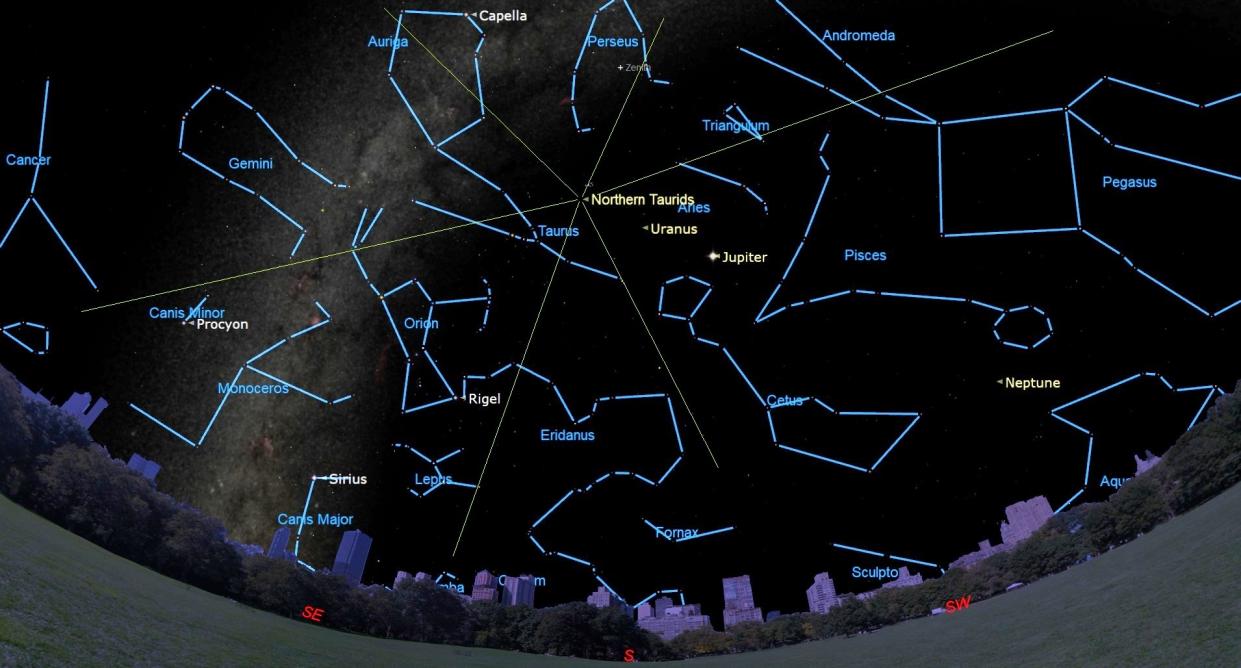The Taurid meteor shower peaks tonight. Here's how to see it.

The Northern Taurid meteor shower peaks this weekend, offering skywatchers the chance to catch brilliant fireballs — if they're lucky.
The peak of the Northern Taurid meteor shower happens overnight on Nov. 11, with its best displays occurring in the hours after midnight. Given clear weather, this weekend should be especially ideal for viewing the Taurids as the moon is approaching its fully-dark new moon phase on Monday (Nov. 13).
For the best chances of catching a meteor streaking across the sky, find the well-known "Seven Sisters" of the Pleaides star cluster in the Taurus constellation. The Northern Taurids' radiant (the point from which the meteors appear to originate) is just below the Pleiades and above the "head" of Taurus, the bull.
If you aren't familiar with the Pleiades, first look for the bright, pale yellow Jupiter shining high to the east. From there, look to the lower left to find a dense cluster of six or seven stars. Just below that will be a V-shaped group of stars on its side, opening to the left; these are the horns of the bull of the Taurus constellation.
Related: Meteor showers 2023: When is the next one?
TOP TELESCOPE PICK:

Want to see the stars and planets of the night sky? We recommend the Celestron Astro Fi 102 as the top pick in our best beginner's telescope guide.
To maximize your chances of seeing a Taurid meteor, find a dark viewing area situated away from as much light pollution as possible. Set up a comfortable seat, bundle up against the autumn evening chill and look skyward in the direction of Taurus or the Pleiades, allowing at least a half-hour or so for your eyes to adjust. At their most active, the Taurids should produce about five meteors per hour.
The Taurids are generally known as one of the slowest meteor showers, but they're also known to exhibit a higher rate of "fireballs," or abnormally bright meteors. "The Taurids are rich in fireballs, so if you see a Taurid it can be very brilliant and it'll knock your eyes out, but their rates absolutely suck," NASA meteor expert Bill Cooke told Space.com. "It's simply the fact that when a Taurid appears it's usually big and bright."
The Taurid meteor showers are caused when debris from the periodic Comet 2P/Encke burns up in our planet's atmosphere. This comet has the shortest orbital period of any known comet at just 3.3 years.
Comet 2P/Encke was discovered in 1786 by French astronomers Pierre Méchain and Charles Messier, but gets its name from German astronomer Johann Franz Encke, who was the first to predict the return of the comet after deducing that several sightings of comets in preceding years were all the same object.
While you're watching for Taurids, you can also snag a close-up look at the Pleaides and the stars of the Taurus constellation by getting the right gear with our guides on the best telescopes and best binoculars.
And while you're at it, you may want to try your hand at taking your own night sky photos with our guides on how to photograph meteors and meteor showers, as well as our lists of best cameras for astrophotography and best lenses for astrophotography.
Editor's Note: If you snap an image of comet C/2023 H2 (Lemmon) and would like to share it with Space.com’s readers, send your photo(s), comments, and your name and location to spacephotos@space.com.

